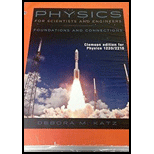
(a)
Angular speed of each child.
(a)
Answer to Problem 36PQ
Angular speed of each child is
Explanation of Solution
Both the child in the question are situated in two different locations. But all points on a rigid rotator rotate with the same angular speed
Write the equation to find the angular speed of the child at the outer edge.
Here,
Conclusion:
Substitute
Therefore, angular speed of each child is
(b)
The angular distance travelled by each child in
(b)
Answer to Problem 36PQ
The angular distance moved by each child in
Explanation of Solution
The angular speed of both the children are same. Therefore the
Write the equation to find the
Here,
Rearrange equation (II) to get
Conclusion:
Substitute
Therefore, the angular distance moved by each child in
(c)
The distance in meters moved by the child in
(c)
Answer to Problem 36PQ
The distance moved by child on inner edge of disc is
Explanation of Solution
The distance moved by each child is different since they are placed at different distance from the center of the disc.
Write the equation to find the distance travelled by the child on the outer edge.
Here,
Write the equation to find the distance travelled by the child on the inner edge.
Here,
Conclusion:
Substitute
Substitute
Therefore, the distance moved by child on inner edge of disc is
(d)
The
(d)
Answer to Problem 36PQ
The centripetal force on child on the outer edge is
Explanation of Solution
Write the equation to find the centripetal force on child on outer edge.
Here,
Write the equation to find the centripetal force on child on inner edge.
Here,
Conclusion:
Substitute
Substitute
Therefore, the centripetal force on child on the outer edge is
The centripetal force acting on the child on outer edge is more. As the magnitude of centripetal force increases, the child will experience strong outward force which makes holding on difficult.
Want to see more full solutions like this?
Chapter 12 Solutions
Physics for Scientists and Engineers: Foundations and Connections
- An object is placed 24.1 cm to the left of a diverging lens (f = -6.51 cm). A concave mirror (f= 14.8 cm) is placed 30.2 cm to the right of the lens to form an image of the first image formed by the lens. Find the final image distance, measured relative to the mirror. (b) Is the final image real or virtual? (c) Is the final image upright or inverted with respect to the original object?arrow_forwardConcept Simulation 26.4 provides the option of exploring the ray diagram that applies to this problem. The distance between an object and its image formed by a diverging lens is 5.90 cm. The focal length of the lens is -2.60 cm. Find (a) the image distance and (b) the object distance.arrow_forwardPls help ASAParrow_forward
 Physics for Scientists and Engineers: Foundations...PhysicsISBN:9781133939146Author:Katz, Debora M.Publisher:Cengage Learning
Physics for Scientists and Engineers: Foundations...PhysicsISBN:9781133939146Author:Katz, Debora M.Publisher:Cengage Learning College PhysicsPhysicsISBN:9781305952300Author:Raymond A. Serway, Chris VuillePublisher:Cengage Learning
College PhysicsPhysicsISBN:9781305952300Author:Raymond A. Serway, Chris VuillePublisher:Cengage Learning Physics for Scientists and EngineersPhysicsISBN:9781337553278Author:Raymond A. Serway, John W. JewettPublisher:Cengage Learning
Physics for Scientists and EngineersPhysicsISBN:9781337553278Author:Raymond A. Serway, John W. JewettPublisher:Cengage Learning Physics for Scientists and Engineers with Modern ...PhysicsISBN:9781337553292Author:Raymond A. Serway, John W. JewettPublisher:Cengage Learning
Physics for Scientists and Engineers with Modern ...PhysicsISBN:9781337553292Author:Raymond A. Serway, John W. JewettPublisher:Cengage Learning Principles of Physics: A Calculus-Based TextPhysicsISBN:9781133104261Author:Raymond A. Serway, John W. JewettPublisher:Cengage Learning
Principles of Physics: A Calculus-Based TextPhysicsISBN:9781133104261Author:Raymond A. Serway, John W. JewettPublisher:Cengage Learning Physics for Scientists and Engineers, Technology ...PhysicsISBN:9781305116399Author:Raymond A. Serway, John W. JewettPublisher:Cengage Learning
Physics for Scientists and Engineers, Technology ...PhysicsISBN:9781305116399Author:Raymond A. Serway, John W. JewettPublisher:Cengage Learning





